

home | books | treeblog | talks | walk of the month | walk directory | contact us
This site is new - more walks will be added as the site is developed.

INTRODUCTION
"On high" because we walk to Ridge, which is a dizzy height of 400ft above sea level. We walk from Shenley, through Pursley Farm to Ridge and back via Ravenscroft Farm.
"with St Christopher" because St Margaret's church in Ridge has an extraordinary mediaeval fresco of a sprightly St Christopher bearing the Christ child on his shoulder. There is a prophetic pylon-like spire to the hermitage, fish in the river and all sorts of other shapes to decipher.
Within St Margaret's is pleasing adzed woodwork. Not only children like searching to find the maker's distinctive mouse signature.
"Tea" because St Margaret's church is open for tea and home made cake 2.30pm to 4.30pm on Sundays from July to the end of September. Also at this time of year, the wild flowers in the hedgerows and the grasses in the meadows are a delight.
Earlier in the year the walk holds a different treat: I have never walked along the footpath beyond Pursley Farm in April without hearing a persistent cuckoo call.
The walk is 4 miles. Tea or pub refreshments half way, and at The White Horse start and finish in Shenley .
The walk displayed here on the walk-talk Website has lots of photos, stories of the houses we pass, links to further information as well as directions (in bold) so that you can take a virtual walk - you can enjoy imagining the walk.
To do the walk in reality, use the print options below to give yourself the level of detail and photographs that you want. The documents are in MS Word format so that you can add your own notes and delete what you do not want before printing.
To print, click: short directions | directions with photos | map
The walk starts and finishes at The White Horse, 37 London Road, Shenley, Herts, WD7 9ER. TL 191002.
Phone, 01923 856315.
HOW TO GET TO THE START
One way to get there from St Albans is to leave town on London Road, go exactly a mile and turn right at traffic lights into Mile End Road. Go under the railway bridge and immediately left into Harperbury Lane. It is now pretty well straight to The White Horse. Following signs to Shenley, you are on the B5378 which becomes Shenley Lane at it skirts London Colney, then Shenleybury after it crosses the M25, Black Lion Hill as it climbs the hill to Shenley, and London Road as it goes through Shenley. The White Horse in on the right, opposite the post office at the far end of Shenley.
There is parking in The White Horse car park.
The pub is very popular indeed - an indication of the excellence of
the food and the pleasantness of the garden and the ambiance in the saloons -
so that if
you are not going to patronise the pub for refreshments and you are there
at a busy time, it would be
courteous to look for parking in London Road, or you may be able to tuck
yourself in down the right fork off Woodhall Lane

which runs alongside the pub.
REFRESHMENTS
There are refreshments at the start and finish at
The White Horse
 and/or,
and/or,
half way round the walk at The Old Guinea pub in Ridge.
Old Guinea pub in Ridge.
The Old Guinea,
Ridge,
EN6 3LH.
TL 215004.
Phone, 01707 642126.
and/or, on Sunday afternoons 2.30-4.30pm July to end
September, in St Margaret's Church.

For more details about the church, go to http://www.stgiles-stmargarets.co.uk/st_margaret_s.html
Both pubs do full menus, bar and dining, and a good range of drinks.
The tea at St Margaret's is as you like it and the homemade cakes excellent.
PHOTO SUMMARY
The walk takes us from The White
Horse, Shenley
along London Road, Shenley
 to
Pursley Farm,
to
Pursley Farm,
through the farm,

across fields
and by flower-filled hedgerows

to St Margaret's church, Ridge,
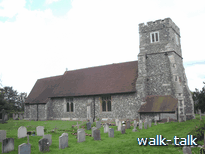
through Ridge,

down to
Ravenscroft Farm,

 and back by fields and wilderness
and back by fields and wilderness
to the pub.

BRIEF DIRECTIONS
Please let me know if you have comments on the walk or my directions.
MAP
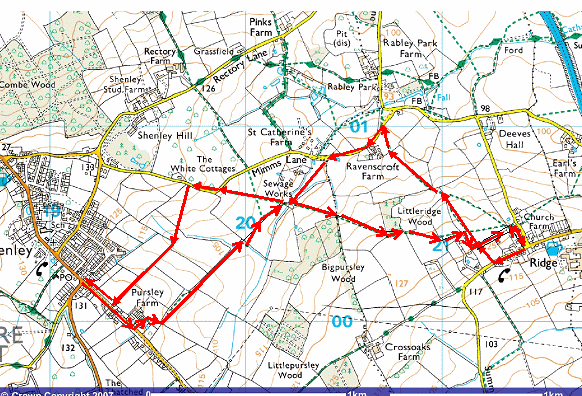
This mapping data licensed from Ordnance Survey® © Crown copyright 2007.
All rights reserved, licence number 100046670.
Roughly, the walk is in the form of a W to Ridge and an M back.
The open-ended arrows represent the route to St Margaret's church, Ridge, the closed-ended arrows the route back.
The return route twice touches the route out so that I thought it would be useful to distinguish between the route there and the route back by making the arrow heads different. Let me know if you found this useful or whether you have another suggestion.
FULL DESCRIPTION - A VIRTUAL WALK
We turn right out of The White Horse,
TL 191002, and cross the road
signed to Borehamwood.
We continue along the pavement
in front of a

variety of houses

with pretty garden s
s
We see on the other side of the road,
the manky willow
tree
 alongside the path
along which we shall return.
alongside the path
along which we shall return.
On our side, we pass the Pursley Farm
football field.

“Elliott Starr” F.C. it also says. If you know any more about the Football Club and for whom it was named , do share your information with us.
There are superb poplars above the hedge.
On the far side,
we pass the first entrance to a farm and then, about 25 yards further on there is
to a farm and then, about 25 yards further on there is
another entrance to the farm alongside
a big black weather-boarded barn
with a wonderfully
steep roof.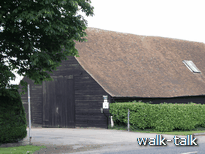
On the roadside is a large board saying “The Hunters Herd, Pursley Farm”
 and also
and also
a
footpath sign “Public Footpath 18, Mimms Lane”.

We cross the road - taking care because cars travel fast along here - and enter the farm through a sliding gate.
TL 194000.  Sometimes it is open but, if not, we are confronted by a wide metal gate barring our way in
and it looks at first as if there is no way through but, against
the hedge on the left, there is a
Sometimes it is open but, if not, we are confronted by a wide metal gate barring our way in
and it looks at first as if there is no way through but, against
the hedge on the left, there is a
purpose built slot for pedestrians.

There is breeze block barn on our left. We pass it, then
angle a little towards the house

then bear left towards a barn with
sage-green
corrugated cladding.

There is a hedge round the house on the right then a wonderful oak and some tanks.
We curve right towards a half-dying ash.

There is
a new hedge on our left.
Then the farm track curves left and we straighten out,
TL196000,

and walk along here, with an older hedge on our left, for a good long way.
There is barley in the field on our right:
 great swathes of
it.
great swathes of
it.
Is it destined for whiskey do you think?
 It can be sold in India now.
It can be sold in India now.
I wonder where this will end up. Perhaps desiccated in a packet of instant scotch broth.
Or is that a different strain?
We pass a Second World War pill box on the left.

Usually they are made of concrete but this one is of brick. During the war there were concrete pillars across Shenley Road. Were they to stop possible German tanks rolling down in to London? Were there others on all approach roads?
There is a clump of cheery Michaelmass daisies in the grasses beyond
the pill box.
in the grasses beyond
the pill box.
Huge electricity pylons are on our right. The wires
are running parallel with our route here but we can see them going away from us
on the far side of Littlepursley Wood.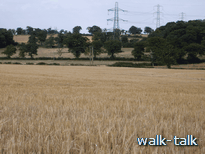
Under a pair of oak trees,
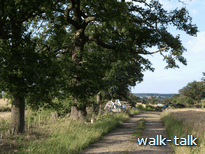
we pass a great pile of logs,
 some of which are birch,
cherry and oak.
some of which are birch,
cherry and oak.
We curve right
and then left round young oaks.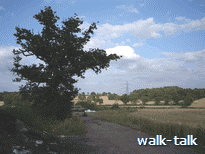
The
track straightens out, TL 200004, and we go under a three-strand line of electricity wires,
 taking note of the sign that says “danger to life” and gives us a picture of how
we would fall off dead if we were heedless.
taking note of the sign that says “danger to life” and gives us a picture of how
we would fall off dead if we were heedless.
Now we have crops on the right and a line of oaks in the
hedge on our left.

If we look at the first oak after the three-strand lines, we see high on the trunk that there is a more-than-large bird box with a tall steep roof. Anyone know what bird it is meant for?
There is a well defined ditch on our left. It could be for
drainage – we are in something of a valley – or be a clear boundary marker.

A remarkably distinct layer of pebbles can be seen in the sides of the ditch and
some sturdy colourful wild flowers.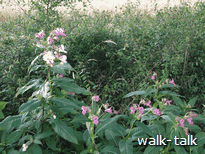
When we come to the edge of the field,
TL 201005, we carry straight on
into the barley.

The path cuts clearly through the planting.
Some farmers are much better than others at keeping rights
of way clear. Two years and a half years ago this path was not marked and the
field of beans impassable. In Hertfordshire County Council there is a team of
people working on our behalf to reconcile the interests of footpath walkers and
farmers and to co-ordinate the excellent work of voluntary organisations that
help to keep paths clear and to maintain gates and foot bridges.
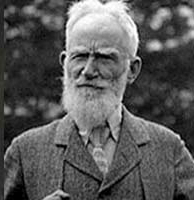
The Footpath Society tries to keep all footpaths walked at least once a year so that our rights of way are kept in effect. In the process of fulfilling this objective, the Society notes where a right of way has not been kept clear and notifies the Council. The farmer is then challenged and requested to comply.
When we see a clear footpath like this, it is to some extent due to the efforts of such organisations and the Council, but the labour and expense is that of the farmer. We owe each of them our thanks and appreciation. We owe thanks, too, to such people as George Bernard Shaw who brought to public notice the fact that as farming practice changed, ancient rights of way that used to be kept clear so that labourers could walk from home to work, were being lost.
At the far end of the field,
 there is an oak tree
there is an oak tree
with a great cleft in it.
 There is also a County waymark post with
its yellow footpath arrow.
There is also a County waymark post with
its yellow footpath arrow.
On the oak itself are
one and a half Shenley-walk  waymarks. One
is numbered 4 but who knows what the other one is.
waymarks. One
is numbered 4 but who knows what the other one is.
This oak is the pivot point of the great W we are walking on our way to Ridge and the M we shall walk on the way back.
It is worth looking round to see where we are. TL 202006.
If we look ahead and to our left along the valley, we see the way we shall come from Ravenscroft Farm and this oak is what we shall want to aim for.
If we turn round, we see that there are three footpaths radiating out behind us. The one on the left (south) is the one we have just traversed. The centre one is the one that we shall want on our return.
We turn back again and veer right (110º)
 cutting
diagonally upwards across the meadow ahead aiming for the left hand end of the solid
bank of trees ahead, Bigpursley Wood and, beyond that, the right hand end of
Litlleridge Wood.
cutting
diagonally upwards across the meadow ahead aiming for the left hand end of the solid
bank of trees ahead, Bigpursley Wood and, beyond that, the right hand end of
Litlleridge Wood.
The path is not well defined but the going is easy. There is a wonderful variety of grasses and even reeds - which is surprising because it is anything but boggy across here - and small wild flowers.
As we reach the corner by Bigpursley Wood, TL 205005,
we cross a deep ditch
 by means of a wooden-board bridgelet. The edges are raised
but boards like these can be very slippery in the wet.
by means of a wooden-board bridgelet. The edges are raised
but boards like these can be very slippery in the wet.
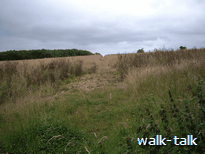
As we come out into the next field, we want to continue in the same direction through the rape-seed field. It is very well defined this year. We are aiming for the right-hand end of Littleridge Wood ahead of us.
The brother of a friend of mine was chatting to an elderly neighbour who said that she had been married at the church in Ridge. She lived in part of Ridge parish west of Shenley. It would have been before the age of motor cars and at a time when you would have to have been well to do to have a horse and carriage. We wondered whether most of the wedding party would have walked up this hill across the meadow just as we are doing.
As we reach Littleridge Wood,
 TL
207004, we go over a stile and then
TL
207004, we go over a stile and then
cross another ditch by means of sleepers.


There is a waymark post
on the corner.
 We turn
left and walk along a wide track
We turn
left and walk along a wide track
with bark chippings underfoot. It seems to be a horse training track.
Littleridge Wood is on our left.
As we reach the end of the Wood,
TL 208004, the horse-training track
curves right and we shall go almost straight on.
As we look to the left we can see some interesting earth works.
Great heaps of soil

and big machines
 are
evident. I wonder what is happening.
are
evident. I wonder what is happening.
Back on track, we go through the wooden kissing gate with a
rope fastener.
 We need to be sure to replace the rope round the post.
We need to be sure to replace the rope round the post.
We enter a
paddock and go on through a gap in the fence
and then through another gate with a strong iron
keeper

into another paddock,

aiming for a spreading oak, a good bit left of the animal shelter.
As we approach the spreading oak, we see a footpath
waymark on the edge of the hedge.
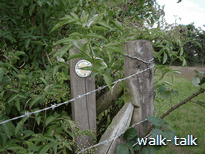
We go a bit further into the corner of the
paddock, through a kissing gate, TL210004,

and into a meadow .
The path is clear
.
The path is clear
to the next kissing gate, TL 21100004.
We ought to be able to go straight ahead now but here the
farmer has not maintained the right of way.
 If
we look carefully, the top of the church tower can be discerned behind the trees
in my photograph. We want
to go through a gap in the trees about 20 yards to the left of a tall oak to the
left of the church tower.
If
we look carefully, the top of the church tower can be discerned behind the trees
in my photograph. We want
to go through a gap in the trees about 20 yards to the left of a tall oak to the
left of the church tower.
We ought to battle through the
crop but it is hard going through the strong rape plants. Last year
there was wheat in the field. Again the path had not been kept clear by the
farmer but a clear path had been trampled through. We might be lucky and the
rape seeds have been harvested making it possible to head straight for the gap
in the trees, but otherwise we shall probably take the easy course
round the field.

We turn left at the top of the field
and then pass a
kissing gate on our right (we shall come back through that). There is a wide stretch of set-aside so that the going is
easy as we skirt the field and there are a lovely flowers and grasses
 to
encourage us and
to
encourage us and
glimpses
to our right of the far view south.

For me, it is annoying that we are having to go round because it means that, for these few hundred yards on our return, we shall be retracing our steps.
After we have turned left at the second corner of the field, we need to keep a good eye open for the
gap in the hedge with a bit of a
stile.

We go through
the gap, TL 214005,

into the neatly kept churchyard.
We see St Margaret’s Church, Ridge, on our right.

The tower has an unusual buttress formation, one buttress coming out diagonally from the corner as one would expect, another at right angles to the wall face where it does not look as if it is doing a buttressing job. The walls are of flint, weathered stone and Hertfordshire pudding stone. Can you spot any of the pudding stone? It is an aggregate of small pebbles.
The church was founded in 1296 as a chapelry in St Albans Abbey lands. The chancel, the bit with a different roof height, further from the tower, dates from the 1300s and probably stood on its own at first. Inside the church,
there is a piscine on the south wall that dates from this very early
time.
on the south wall that dates from this very early
time.
Was there a substantial community here at that time or was there a lot to do in managing Abbey estates? The Brockett Arms in Ayot St Lawrence is said to be a monks’ cell attached to St Albans Abbey, presumably housing men who looked after Abbey estates’ interests. It is a homely building, nothing like this proper stone building, even if it were at first only the size of the chancel. Please share any knowledge or ideas you have as to why this was the site of such a substantial church building.
The nave and tower were built in the following century, "confirmed by bequests made from 1410-1440" ( Jenny Wilson 'A Walk through Ridge'). I wonder who made the bequests. The manor of Tyttenhanger, which later included the patronage of Ridge church, belonged at that time to St Albans Abbey, given centuries before to the monastry "by a pious Saxon lady called Thurefleda."
The church website www.stgiles-stmargarets.co.uk, speaks of the Roman road from St Albans to London passing near by. I presume that would be Watling Street which pretty well followed the old A5 through Park Street and Radlett, less than 5 miles west of Ridge. However, I would have thought that 5 miles in the 1300s was a long way.
Later, the presence in the vicinity of large wealthy family estates - Tyttenhangar, Dyrham Park and High Canons - would have helped to maintain the church.

If we have been clever enough to come on a summer Sunday afternoon between 2.30 and 4.30pm, we can go in, not only for tea or coffee and home-made cakes, but for the pleasure of the interior of the church. If there are children amongst us, they will enjoy finding the little mice carved into the woodwork by craftsmen of Robert Thompson’s workshop. Thompson is known as the Mouse Man.
We go in through the porch on the south side of the church.
Standing on the font

is a plate to collect our contributions for tea and cake. All proceeds go the Church.
our contributions for tea and cake. All proceeds go the Church.

Ask for your tea and choose your cake and then take a look
round you.
The Church is a mixture of old and new and there is a treasure house to explore but
it is the mediaeval painting that faces us as we walk into
the church that is most amazing.

On the Church website, we can view an un-reduced photograph of the painting by going to http://www.stgiles-stmargarets.co.uk/IMG_0031.jpg.
The 500-year-old painting depicts St Christopher carrying the Christ child across the ford.
The board at the side is exact:

“In the middle ages the interiors of churches were often decorated with frescoes, the figure of St Christopher being frequently seen opposite the common entry of the church. As many as 350 such figures exist in varying states of preservation.
The story is that while St Christopher was seeking his Master, he was advised by a hermit to undertake the work of carrying travellers across a dangerous ford. On one occasion being asked by a child to carry him across, he finds the weight insupportable whereupon the Child tells St Christopher that he is carrying the burden of the world and that he is the Master sought. He commands St Christopher to plant into the bank his staff which bursts into fruit and leaves.
In Ridge Church, St
Christopher is seen standing slightly turned to the right holding in his left
hand an oak staff bursting into leaf. Clad in a short red grey-lined mantle he
stands in the stream in which fish may be seen swimming.
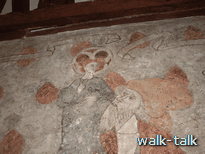
On his right shoulder, regarding him with upturned face he
bears the Child clothed in grey with a cruciform nimbus about His yellow hair and is in the act of blessing.
On the opposite bank, partly hidden by a tree is the hermitage
surmounted by a spire and at the door stands the hermit with a large lantern on a crook staff. The background is covered with a brocade pattern whilst a scroll with the remains of a text heads the picture. Compared with other representations, this example dating from the second half of the fifteenth Century is well preserved and its existence is of considerable value to the church. Compiled from the report of Professor E W Tristram."
“[The painting] was restored by Professor Tristram in 1937 and it has since been treated by Mrs Baker an expert in mediaeval painting.” (Jenny Wilson, ‘A Walk through Ridge’)
Pevsner refers to the fresco as “very raw”. I find it appealing and Pevsner's statement puzzling for the detail is fine and the movement and therefore vitality greater than in most church painting. The Church leaflet tells us that "[the fresco] is probably by the same hand as the wall paintings of this date in St Albans Abbey." The figures in the paintings there, too, are anything but stiff.
There is a jauntiness in the lift of St Christopher’s heel and knee and in the lilting skirt line; a solemnity in the face of the un-childlike
Christ with His strange halo with the unfortunate look of ram's horns, and his hand with thumb and two fingers held out;
a balance between St Christopher’s funny squashy-looking headgear and out-flung
sleeve line;
and in the lilting skirt line; a solemnity in the face of the un-childlike
Christ with His strange halo with the unfortunate look of ram's horns, and his hand with thumb and two fingers held out;
a balance between St Christopher’s funny squashy-looking headgear and out-flung
sleeve line;
 a curiosity and concern in the Saint’s face; the Saint’s hand on
his hip leading us to the line of his leg; the steadiness and strength conveyed
by the sprouting staff;
a curiosity and concern in the Saint’s face; the Saint’s hand on
his hip leading us to the line of his leg; the steadiness and strength conveyed
by the sprouting staff;
the well drawn lantern
hanging from the prosaic crook;
and the hermitage with its
steeple that is so like a modern pylon that it cannot but raise a smile.
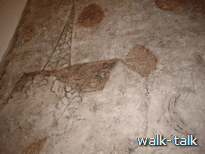
I thought at first that the banana-shaped object twixt hermitage and lantern must be one of the fish promised by the description on the board but on closer inspection I think that it is the hair line of the hermit as he tilts his head back, chin up, to look at the Child. If this is the case, the crooked staff that seems to be stuck into the bank of the river but which we are told is being held by the hermit, starts a bit below the hermit’s waist at the start of the lines of his skirt going downwards and to the right. We can just make out the hermit's elbow crooked well back and the horizontal line of his sleeve, also in downward dark lines.
The fish, I think, are the reddish elongated blobs, bottom left. Or do you think the blobs are part of the brocade?
What of the arch in the lower right corner? Do you think that beneath it there is a seated lady with mediaeval headdress?
Do share with others your perceptions of the painting.
The tapestry work on the north wall above the pulpit is
worthy of note.
on the north wall above the pulpit is
worthy of note.
It depicts the Royal Arms of George III. The painted board hanging below it with the date 1814 on it was found on the back of the tapestry frame. What would today’s equivalent be? Posh and Becks in a football roundel? What would we choose as a suitable subject for a church tapestry today? Let me know.
The oak pulpit was made by Robert Thompson in 1957.
 We
can see his mouse signature at its base below the linen fold panelling.
We
can see his mouse signature at its base below the linen fold panelling.
The oak furniture
in the chancel
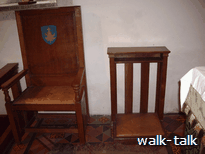 was
commissioned in 1965 by Major Behrend in memory of his wife Edith.
was
commissioned in 1965 by Major Behrend in memory of his wife Edith.
Note the open-mouthed golden dragon in a blue shield on the chair in the chancel. There is a sword down its throat. St Margaret of Antioch, to whom the church is dedicated, was attacked by a dragon and she successfully fended it off by thrusting a sword into its mouth. There is a tiny dragon, too, alongside St George in the tapestry on the south side of the chancel.
Yet more furniture was
commissioned for the millenium and even more as an occasional gift from members
of the church. All were made by Robert Thompson's workshop in Kilburn,
Yorkshire. It is
referred to as "adzed work" .
I understand an adze to be a cutting tool and if we look closely, particularly
at the chair in the sanctuary, we can see the cutting marks. I suppose that
where the surface is absolutely smooth, the furniture has been sanded so.
.
I understand an adze to be a cutting tool and if we look closely, particularly
at the chair in the sanctuary, we can see the cutting marks. I suppose that
where the surface is absolutely smooth, the furniture has been sanded so.
Here are are some of Robert Thompson's signature mice that I spotted.
How many can you find?
Some are in 3-D,
 and some are carved into the woodwork.
and some are carved into the woodwork.

Sometimes we can see
the nose on one
side of a leg

and the tail on the other
as if the mouse has crawled in through a hole
and is coming out
of the other side.
The window on the south side within the sanctuary has vivid blue and red
colours. It was done in the 1980s by Chapel Studios .
.
A much older stained glass window is on the north side, we learn from the Church guide book: fragments date from 1390.

St Margaret of Antioch,
for whom the church is named,
is depicted in the central glass
of the East window.
The bells of St Margaret's are exceptional for a small
country church:
 the earliest is the tenor. It dates from 1613, and the treble
dates from 1685. The second is dated 1765 and was cast by William and Philip
Wightman.
the earliest is the tenor. It dates from 1613, and the treble
dates from 1685. The second is dated 1765 and was cast by William and Philip
Wightman.
I find it thrilling that two new bells hung - and rung - in 1998 were cast at the Whitechapel foundry where their now-companion tenor and treble were cast more than 300 years before.
A sixth bell, which comes from another church was also added in 1998, the three additional bells and their installation were all funded by the lottery millennium fund and local fund raising in equal shares.
Boards on the wall at the back of the church record peels rung.
There are some colourful kneelers
to
enjoy

for their workmanship

as well as their design .
.
The roof was renewed in 1976.

We leave the church, and go out down the path.
It is amusing to look back up at the tower
where we can see
a door
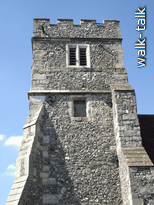
too high up to be accessed by anyone but an angel or a person on an exceptionally tall ladder. Perhaps both: Jacob’s angel’s were ascending and descending on a ladder. What is odd is that the handle looks made to be pulled towards the outside yet the door abuts against the stone on the inside. Is there something obvious that I am missing? Put me straight.
Ahead of us is a white house, once the vicarage,
now called Grove
House .
It dates from the 1890s and is huge. In 1963 it was sold and the new vicarage,
The Medlars, of which more anon, was built as a replacement.
.
It dates from the 1890s and is huge. In 1963 it was sold and the new vicarage,
The Medlars, of which more anon, was built as a replacement.
We continue down the path from the church and look over to
the left. When we get close to the gate we come level with a particularly white
headstone,
 close to the ground, almost horizontal but slightly sloping up at the
far end.
close to the ground, almost horizontal but slightly sloping up at the
far end.
The commemoration reads:
“In memory of Alex, Field Marshall 1st Earl
Alexander of Tunis, Knight of the Garter, born 10 December 1891, died 16 June
1969, and his wife Margaret, born 16 September 1905, died 17 August 1977.”

Field Marshall Alexander was a tall handsome charming confident man in appallingly responsible positions: Commander of a battalion on the Western Front in the First World War; Supervisor with Montgomery of the evacuation of Dunkirk in 1940; Commander in Burma, where he narrowly avoided capture by the Japanese in the evacuation of Rangoon in 1942; Commander in Chief, Middle East during El Alamein and the rest of the campaign in North Africa (1943); Field Marshal, and as Commander in Chief, Mediterranean, for the campaign in Italy (1943-5).
Earl Alexander's full name was Harold Rupert Leofric George Alexander. He and his brother Eric, who inherited the family's Irish earldom and became the 5th Earl of Caledon, used to stay with their father's sister Lady Jane van Koughnet at Tyttenhanger House. St Margaret's was in the patronage of the Tyttenhanger estate and the lads, who often stayed with their aunt, would come to the church with her. Jenny Wilson writes that her father "was told that Aunt Jane and the boys always entered the church by the small chancel door and sat in the chancel, being the Lord of the Manor's part of the church , with the nave for the commoners. Manorial courts were sometimes held at the chancel step, a dividing line of significance." (Jenny Wilson "A Walk through Ridge")
We go through the church gate and on to
the “village green where past scenes of fetes, sports days, and the gathering of horses and hounds
ready for the hunt, children's’ and old peoples’ parties are here to haunt us."
(Ibid) We go under an attractive cherry tree on the green.
where past scenes of fetes, sports days, and the gathering of horses and hounds
ready for the hunt, children's’ and old peoples’ parties are here to haunt us."
(Ibid) We go under an attractive cherry tree on the green.
The village hall is behind us on the left. It is "on the
site of Ridge House…. built about 1800 to accommodate a school previously
established by Elizabeth Whalley" wife of Rev Robert Whalley, vicar of Ridge
church. (Jenny Wilson ‘A Walk through Ridge”). One
“Sarah Reed was [mistress of the ‘Boarding Academy’] in 1833 and she died in the
Almshouses in Ridge aged 82 years.” (Ibid) “The 1871 Census Return records the
house to be a ‘Convalescent Hospital’ run by six Sisters of Charity with 16 male
and 14 female patients aged between 3 and 54 years…The 1881 census shows the
house to be uninhabited and this was so when acquired by Captain F Trotter [of Dyrham Park] in 1895.” (Ibid). “Captain Trotter pulled down Ridge House to first
floor level and re-roofed it, providing a Parish Room in part of the remaining
premises for the village.” (Ibid)
is behind us on the left. It is "on the
site of Ridge House…. built about 1800 to accommodate a school previously
established by Elizabeth Whalley" wife of Rev Robert Whalley, vicar of Ridge
church. (Jenny Wilson ‘A Walk through Ridge”). One
“Sarah Reed was [mistress of the ‘Boarding Academy’] in 1833 and she died in the
Almshouses in Ridge aged 82 years.” (Ibid) “The 1871 Census Return records the
house to be a ‘Convalescent Hospital’ run by six Sisters of Charity with 16 male
and 14 female patients aged between 3 and 54 years…The 1881 census shows the
house to be uninhabited and this was so when acquired by Captain F Trotter [of Dyrham Park] in 1895.” (Ibid). “Captain Trotter pulled down Ridge House to first
floor level and re-roofed it, providing a Parish Room in part of the remaining
premises for the village.” (Ibid)
On our far left - on Deeves Hall Lane - are the interesting
old barns of Church Farm . They have a preservation order on them but the look as
if they could do with a bit of TLC.
. They have a preservation order on them but the look as
if they could do with a bit of TLC.
If it is not a Sunday so that we were unable to refresh
ourselves with tea and cake in the church, or if we want additional sustenance,
the Old Guinea public house, TL 215004,
 is
a few yards to our left. Originally it was a house built in 1720, converted in
1750 to a public house, Benskins Watford Brewery bought it in 1898 and it was
rebuilt in 1903.
is
a few yards to our left. Originally it was a house built in 1720, converted in
1750 to a public house, Benskins Watford Brewery bought it in 1898 and it was
rebuilt in 1903.
Nelsons published a novel by George Sellick who “sets his first
few chapters in The Old Guinea, Ridge, telling of late 18th Century
highwaymen who infested Ridge Hill and robbed the St Albans stage coaches.”
(Ibid) Did the St Albans stage coach traverse Ridge Hill?

In front of us and a little to the left, on Cross Oaks Lane is the replacement vicarage, designed by Jenny Wilson’s father Ted Salter. It is called The Medlars, which are interesting and now-rare trees. I wonder if the tree in the front garden is a medlar. There is a medlar in Old Welwyn that has a plaque against it saying that it may be the only one in Hertfordshire so that I would be interested to know if there is such a tree – or even trees, given the plural of the house name - here. The fruit looks like tiny monkey skulls and is only edible once it is rotten. The tree originated in Persia and was popular in English Victorian gardens seeking a quick gothic effect, not only for the skull-like fruit but because they look gnarled and ancient and interesting even in their infancy. They are self pollinating and do not grow too large which makes them a useful tree in today’s smaller gardens and perhaps will make them popular again and not so rare. We would be well advised to learn what the Victorian's knew: to wait until October to pick the fruit and then to leave it to "blet" or until it "reaches the "bletting stage".
There is a lovely long view ahead beyond the houses.
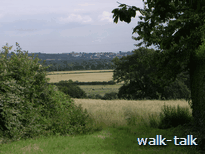
For our walk we go right on Cross Oaks Lane, following the direction of the sign to ‘Bmwood’ for which read ‘Borehamwood’.
There are lovely trees on the right at the bottom of Grove House garden: a yew, a copper beech
on the right at the bottom of Grove House garden: a yew, a copper beech
and a very pretty willow .
 My friend Stuart is
sure it must mean that there was once a pond here once.
My friend Stuart is
sure it must mean that there was once a pond here once.
Note the telephone kiosk. It was designed by Sir Giles Gilbert Scott, grandson of Sir George Gilbert Scott who, we think, designed the arms houses over the road.
On the drive into
the alms houses is an exceptional yew tree.

Usually you have the new yew shoots all around the base of a yew tree but on this one the trunk is absolutely clear and the branches do not start until a good six feet up.
The drive is in to Orchard Mead,
a set of arms houses which are said to be
are said to be designed by Sir George Gilbert Scott as
five separate dwellings.
 I
find them exquisite.
I
find them exquisite.
The “delightful cottage-style gardens
 are reputed to
have been laid out by Gertrude Jeckyll” according to a Countryside Management
Service Circular Cycle Ride: Shenley & Ridge. (http://enquire.hertscc.gov.uk/cms/explore/cycle/shenley.htm)
are reputed to
have been laid out by Gertrude Jeckyll” according to a Countryside Management
Service Circular Cycle Ride: Shenley & Ridge. (http://enquire.hertscc.gov.uk/cms/explore/cycle/shenley.htm)
The plaque on the front says "1844. These arms houses were erected in accordance with the wish of Miss Jean Trotter of Dyram Park“. Jenny Wilson's words are "for the old of the village. Each [dwelling] provided three rooms which were rather small and very dark. Outside at the back they had a long garden with only a path for a boundary.
"All had an impressive view over the lovely farming countryside looking south towards Barnet.
"The communal gate at the front of the property led to a path which divided only as it reached the central front door, the remaining hour were accessed around the back where communal porches enclosed the two doorways at each end of the building.” (Jenny Wilson ‘A Walk through Ridge”).
It sounds from what Jenny Wilson goes on to say, that, at least by 1950 when the last lady was still living there, that there was at least one toilet and there was running water. (Ibid) My understanding from having been shown round the Pemberton Arms Houses in St Peter Street, St Albans, is that those were originally each of a single room only. They were built in the mid 1600s but, even so, they do make the three-room dwellings here seem generous.
To the right of the road, beyond the willow there is a pleasingly simple but substantial white house
 with a working courtyard of
barns
with a working courtyard of
barns

and stables.
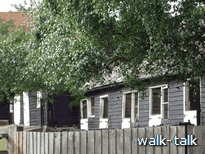 This is Ridge Farm.
This is Ridge Farm.
Opposite Ridge Farm is The Forge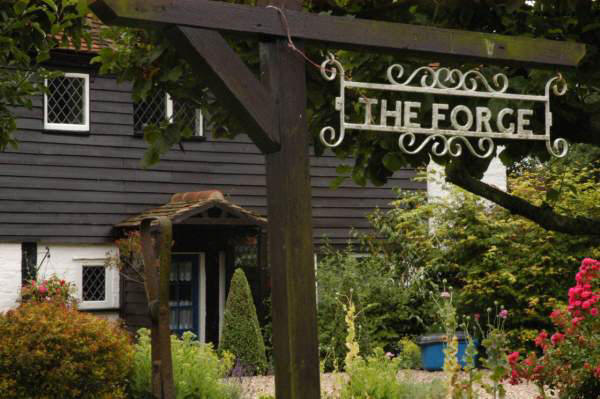
with its quirky
garden ornaments

and colourful garden.
 A member of the present incumbent family,
David Worster, sent these photos of the buildings.
A member of the present incumbent family,
David Worster, sent these photos of the buildings.
The forge was where the timbered building is to the left of the house.
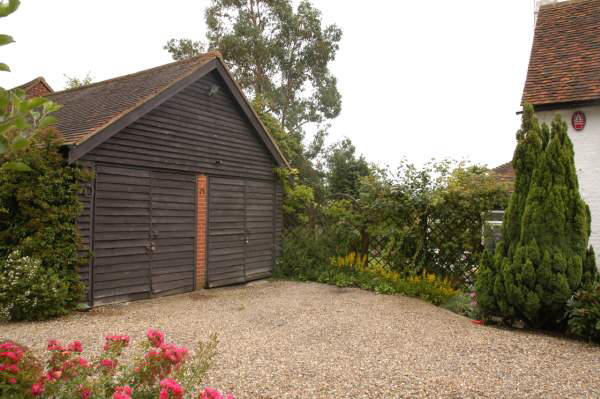
The roof line has two levels.
 Although Jenny Wilson (Ibid.) says that originally the house was two cottages,
the present owners tell me that there were three, and that the reason for the
change in roof line was that the one on the left had become derelict and had to
be re-built.
Although Jenny Wilson (Ibid.) says that originally the house was two cottages,
the present owners tell me that there were three, and that the reason for the
change in roof line was that the one on the left had become derelict and had to
be re-built.
The Old Forge was built in the 1600s and is a listed building. The changes were made sensitively, keeping as much of the original as sensible.
In the 1940s and 50s, Alf Smith and his sons lived in the cottages, Jenny Wilson tells us. He was a chorister in St Margaret's’ church choir and the village postman until he retired and became local road sweeper and chimney sweep.
Next is Kitwells,

where Jenny Wilson’s parents moved from Orchard Mead.
Then we have Ivy Cottage.
 Originally it was a timber-framed
building with weather boarded walls and roof and, at least from 1793, it was the
Poor House and was re-built in 1843 from a timber-framed building into the
attractive brick building we see here. Jenny Wilson speaks of people
purchasing the house when it was no longer used as a Poor House and speaks of
the alterations they did to the house in 1956. Could it have been a Poor House
until the 1950s?
Originally it was a timber-framed
building with weather boarded walls and roof and, at least from 1793, it was the
Poor House and was re-built in 1843 from a timber-framed building into the
attractive brick building we see here. Jenny Wilson speaks of people
purchasing the house when it was no longer used as a Poor House and speaks of
the alterations they did to the house in 1956. Could it have been a Poor House
until the 1950s?

Bay Tree Cottages was The Sovereign pub until the First World War.
It is now two cottages and we can see to the right of the second one a small building with a good front window.
It used to be a shop selling hardware, fresh produce, ice creams
and anything else you asked to be acquired on your behalf.
It was Olive Males’ shop.
She lived in the cottage,
had worked in the shop at South Mimms
and then opened this one and only shop in Ridge. (Ibid)
Rose Cottage is next.

It has a lovely colourful garden in
the summer.
It is opposite Rose Cottage,
 before the de-restriction sign
on the road, that we cross the road and go through the kissing gate by the sign
“Footpath 22” and into a paddock. TL 213003.
before the de-restriction sign
on the road, that we cross the road and go through the kissing gate by the sign
“Footpath 22” and into a paddock. TL 213003.
Note how humpy bumpy the ground is.
 There
are many lost settlements in Hertfordshire and humps and tumps (the correct
technical term) like these can be an indication of ancient dwellings.
There
are many lost settlements in Hertfordshire and humps and tumps (the correct
technical term) like these can be an indication of ancient dwellings.
We can see the church over to our right.

We make for the
kissing gate to the right of the wide metal gate straight ahead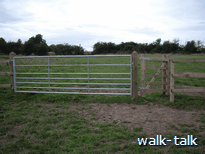
and then straight on and again through another kissing gate
 and
out into the field that we came up round. There is some attractive white bryony
climbing over the hedge.
and
out into the field that we came up round. There is some attractive white bryony
climbing over the hedge. Its leaf is maple-like.
Its leaf is maple-like.
See how dry the rape seed is.
 It
looks as if the pods will burst and the seeds be scattered before they can be
harvested - or perhaps the farmer has done that before we come walking today.
It
looks as if the pods will burst and the seeds be scattered before they can be
harvested - or perhaps the farmer has done that before we come walking today.
We go left round the field and, at the end of field, right.

We see again the foxgloves
 attractively
set amongst pale grass heads
attractively
set amongst pale grass heads
by the house
 that
we passed on our way up and the kissing gate that
we came in through. The cladding here is shingles rather than boards.
that
we passed on our way up and the kissing gate that
we came in through. The cladding here is shingles rather than boards.
We pass the kissing gate through which we came on our way up and continue on down the hill. We go under our familiar three-strand overhead wires, and then another lot of the same.
There are lovely long views to the right.

We can see a land-mark silo and traffic on the M25 – the A1(M) is a bit further away to the east, our right, and not visible or audible from here. To me, the colourful bead-like cars and lorries and their movement add to the interest of the scene. How fortunate we are to be out in the country and not sealed in a vehicle on a motorway.
The lady in the church told us that a footpath from the silo to Coursers Farm has been deleted. They are doing gravel extraction there. I wonder whether in the long term there will be a lake as there is at Broadlakes in London Colney.
It is, however, always a loss when a right of way goes.

The flowers
in the borders of the field are
lovely - birdsfoot trefoil, white clover and pink clover  -
-
and the grasses a beautiful soft
buff and pink.
The hedge has at least four different species growing in it. Pollard, Hooper and Moore shows that the age of a hedge correlates well with the number of woody species in it.: the age of a hedge in hundreds of years is approximately equal to the number of woody species per 30 yard stretch. So if there are 4 species, the age of the hedge is about 400 years. We can assume then, that this hedge was planted about 1600, the end of the reign of Elizabeth I.
I counted field maple - it will be liquid gold in the
autumn,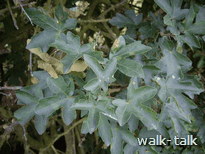
hawthorn,
blackthorn - we can come back to gather sloes in autumn,
and
 hazel.
hazel.
The textures and variations of
colour and leaf shape in the hedge are a delight:


At the end of the hedge, TL 210007,
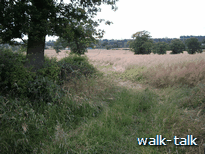 we
curve left and then right, straightening up to continue in the same direction
we
curve left and then right, straightening up to continue in the same direction
going to the left
of the oak ahead.  Far ahead of us and a bit to the left is a Dutch barn,
Far ahead of us and a bit to the left is a Dutch barn,
one with a barrelled roof.
 To
the left of that is a cream and brown house and to the left of that a cream
house.
To
the left of that is a cream and brown house and to the left of that a cream
house.
That is Ravenscroft Farm and surrounding places and we want to be to the right (east) of them.
We continue in the same direction as we pass another oak at the end of a hedge going away from us to the right.
There is more of the
delicate white bryony,
some tawny red maple seeds
(straight for maple, Y-shaped for sycamore)

and a coral parasite to catch our eye on that hedge.
to catch our eye on that hedge.
We can see a line of oaks through the field on our left. It probably marks a previous hedge line so that there would have been several smaller fields before all were amalgamated into this large one to make mechanical management more efficient.
It is dry and cracked underfoot despite recent rain.
We need to be wary of unexpected holes in the ground that can turn an ankle.
There are long views away to the
right
See a dark barn, ahead and on the far right,
 a
white house ahead and a bit right.
a
white house ahead and a bit right.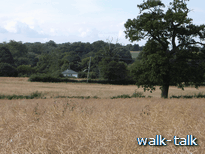
Now we come to the four-barred fence around the house,

and note
the “RIdge 21”
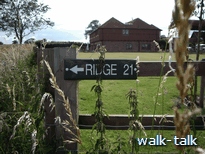 sign on the fence.
TL 207009.
sign on the fence.
TL 207009.
The arrow points back the way we have come. We were told we were on Footpath 22 as we came off the road at Ridge and have not changed direction, so that it is interesting that the number of the footpath has changed.
We keep on in the direction we have been walking, keeping the fence on our left. Saplings have been planted along the house-side of the fence, presumably to shield the house from the eyes of walkers like ourselves.
We pass under a two-wired post.
Pretty summer flowers grow along the edges of the path ,
,

colourful leaves

and spikely plants amongst the pale grasses:

It looks as if there is no way through at the end of this
path
 but there is:
we go through a gap and something of a stile. TL 207010.
but there is:
we go through a gap and something of a stile. TL 207010.
Be particularly careful
crossing the wooden bridgelet
 over the ditch out on to the road because the boards slope and are slippery in the wet,
over the ditch out on to the road because the boards slope and are slippery in the wet,
and the road, Mimms Lane, is narrow.
It would be good to be able to go straight across the road on to the signed footpath and cut through the meadow to the left but, despite the markings on OS maps, the footpath shown is in dispute. If, however, you have a picnic with you or want to stop for a bit of a rest, there is a glade under oaks a few steps in.
What we do is go left along Mimms Lane.
We can see the black
weather boarding
 on one of the buildings in the Ravenscroft Farm complex ahead
of us. We go towards that, enjoying the white flowers in the borders: fluffy
ones
on one of the buildings in the Ravenscroft Farm complex ahead
of us. We go towards that, enjoying the white flowers in the borders: fluffy
ones

and an umbellate
one
 which
attracts insects with exquisite transparent wings: some green with a blue sheen,
most bronze.
which
attracts insects with exquisite transparent wings: some green with a blue sheen,
most bronze.

The road is narrow and cars speed along it. I suggest we walk on the left where we are on the outside of the curve giving us maximum visibility and where it is possible to leap up on to the verge if necessary.
We soon come level with the entrance to “Ravenscroft
Farm”

and “Ashridge Lodge”.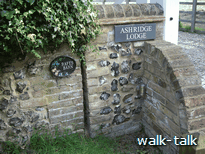
Behind the converted barn on the road edge, we see clearly a graceful timber-framed pinkish-cream house.

We continue on the road but not for further than we have come since we came out of the fields.
There are more flowers to enjoy. I have given the names of those I can identify. Do you know the names of the others?
 agrimony
agrimony
 brambles
brambles
buttercups
and lots of poignant elm hedge ,
,
with its rough-textured leaves
alternating along the stem.
Through a new double-cross wooden gate on the right of the road, we can see a wide grassy field and beyond it jade lawns, a roof and out buildings. It is a picturesque view.
The road starts to slope down quite
steeply to Catharine Bourne and, immediately after road signs,
 the
hedge curves left and we curve with it,
the
hedge curves left and we curve with it,
left up
a short steep slope.
TL 204008.
The sign high in the hedge says
only “Public Footpath”.
We come
out into a rough scrubby meadow. There is no sign of a path across. We must make
our own way across straight ahead, roughly 225º (south west), well to the right
and away from the hedge line on our left with its odd distinctive oak branch.
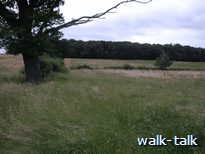
The line of the Bourne is heavily
treed and we walk parallel to it keeping it on our right.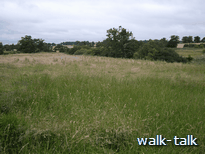
We aim for an oak and
a good gap in the hedge in the corner of the open space ahead of us.
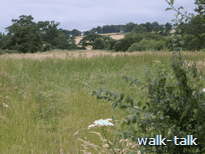
Hard by the oak we see the culvert taking Catherine Bourne.
The oak turns out to be our old friend

with the one and a half Shenley-walk waymarks
tacked to its breast. TL 202006.
This is where there are three paths through the
field ahead. We want the one in the middle
 that slants upwards at 280º (just
north of west). (The path on the right is the footpath shown on maps as coming
down to join our one a bit further up the hill.)
that slants upwards at 280º (just
north of west). (The path on the right is the footpath shown on maps as coming
down to join our one a bit further up the hill.)
We come out on to the road again, TL 199007, still Mims Lane .
.
What we have done is walk two sides of a triangle to avoid having to keep to the road.
We go left on to the road, then follow it as it curves immediately right
then straightens out

and soon we can see “The White Cottages” coming up on our
right but,



BEFORE we get to
the cottages themselves, about opposite their entrance there is a gate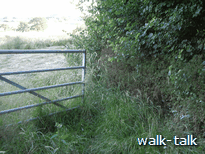 on the left
on the left
and a gap in the
hedge marked Footpath 19.
 TL
197007.
TL
197007.
We go through the gap and go straight ahead on to a footpath that is going to
lead us straight back home to London Road, a little nearer to Shenley (and The
White Horse) than our
Pursley Farm entrance.
on to a footpath that is going to
lead us straight back home to London Road, a little nearer to Shenley (and The
White Horse) than our
Pursley Farm entrance.
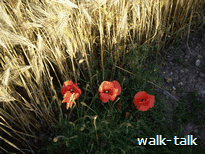
We might be tempted
to go right, skirting the field, it seems the direct way back to our starting
point, but if we look up at the horizon we can just make out the sage-green
barn of Pursley Farm.
 We
want to head a bit to the right of it.
We
want to head a bit to the right of it.
We come up to a kissing gate and go through.

The path goes down bearing a bit to the left aiming for the
end of the hedge ahead TL 196004.

Over to the left we can see the
line of oaks we followed on our way towards Ridge.
At the end of the hedge there is a wooden bridgelet across
the ditch and another kissing gate, which we go through and head straight up the
hill
 with
the hedge on our left.
with
the hedge on our left.
The grasses are very pretty as we climb the hill. The sun
is shining on the buff and browny mauve of the grass heads,
 the
long shadows unable to quench the emerald of the path through the grass. There
are lots of butterflies.
the
long shadows unable to quench the emerald of the path through the grass. There
are lots of butterflies.
There is an aluminium-coloured gate that is usually set
open but, if not, we go through it.

We pass an oak on the left with a
great spur of a root.
We go on, still with the hedge on our left,
still with the hedge on our left,
but take time
 to
look through to the long lovely view over our left shoulder.
to
look through to the long lovely view over our left shoulder.
Ahead
 and
to our right we can see, beyond the manky weeping willow a half-timbered house
on London Road.
and
to our right we can see, beyond the manky weeping willow a half-timbered house
on London Road.
We go through
another kissing gate close to a house on our left, pass the house and out into
London Road, Shenley. TL193001.
We cross London
Road
 and
turn right,
and
turn right,
then cross Woodhall Lane to The White Horse.

TL 191002.
I am grateful to the following people for sharing information with me:
To my friend Stuart Henderson for introducing me to the walk, to Ridge and to St Margaret's, and lending me Jenny Wilson's 'A Walk through Ridge' until I could get a copy of my own.
Joan and David Badger for telling me about St Margaret's church and its work and, especially, for sharing the excitement and pride of the bell ringers in winning lottery millennium funding for restoration and addition of the bells.
Patrick Hastings for referring me to the churches' website and helping me find out if the arms houses in Ridge were designed by Sir George Gilbert Scott.
To David Worster and his family for providing me the excellent photographs of The Forge and telling me about its history, lending me a copy of 'A Walk through Ridge' and alerting me to interesting history of the houses along the road.
Tea on high with St Christopher
To print, click: short directions | directions with photos | map
home | books | treeblog | talks | walk of the month | walk directory | contact us